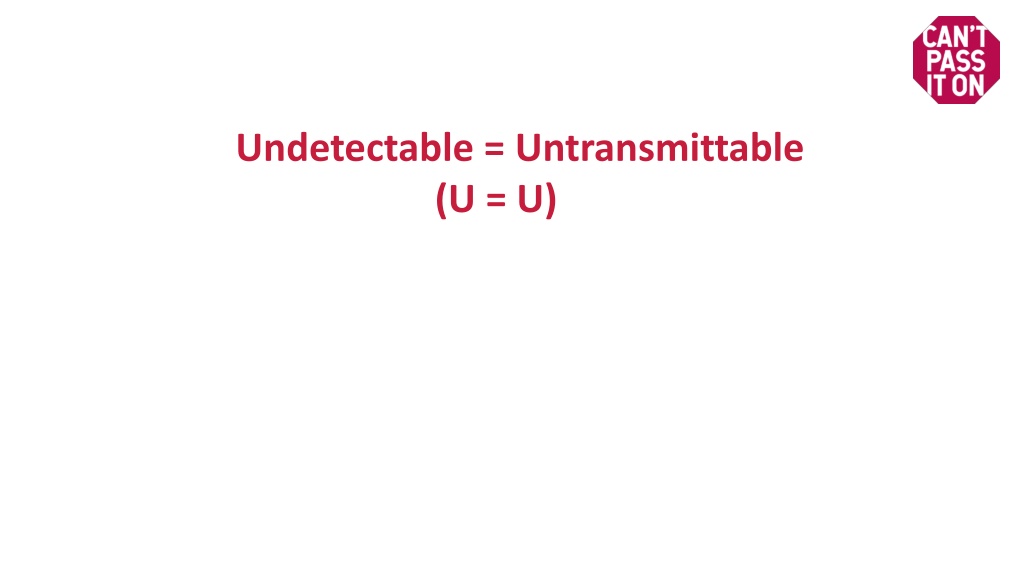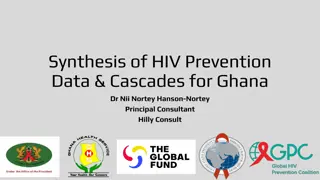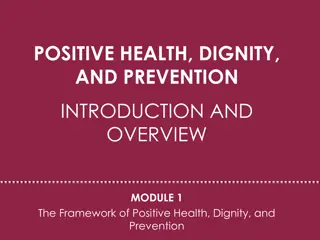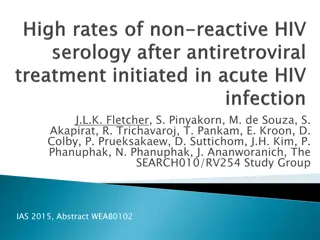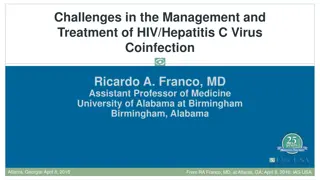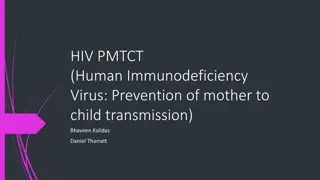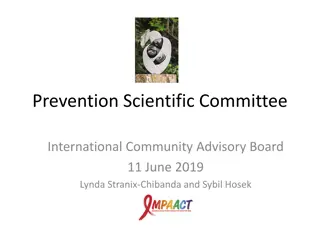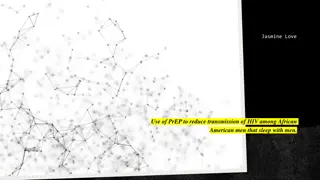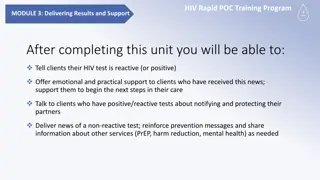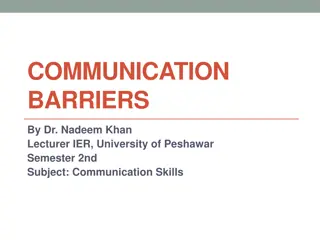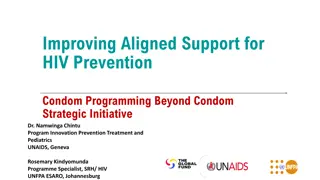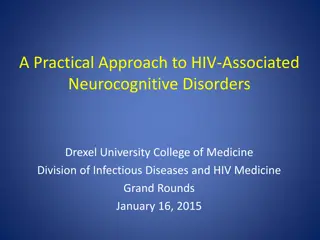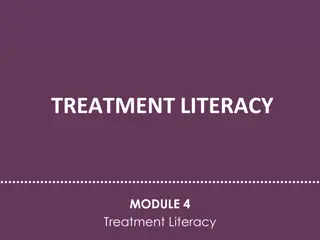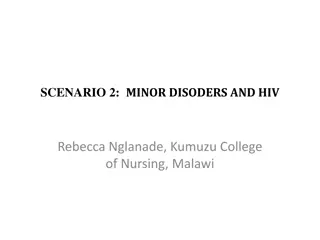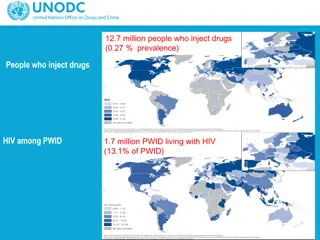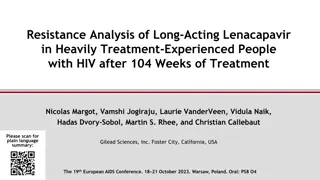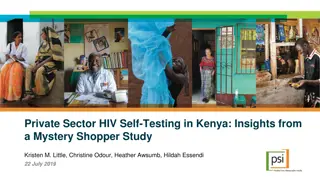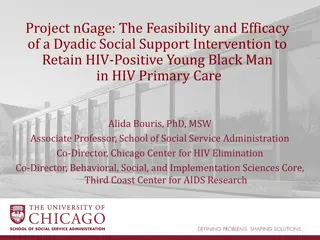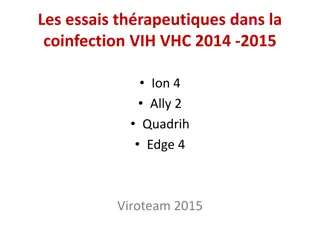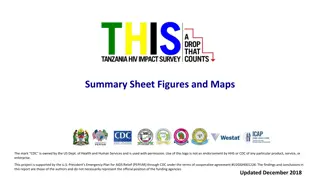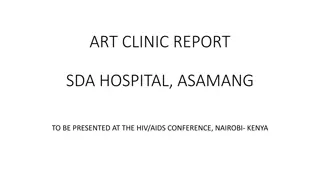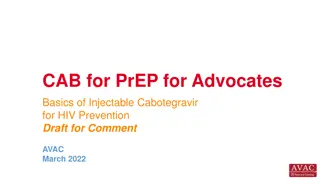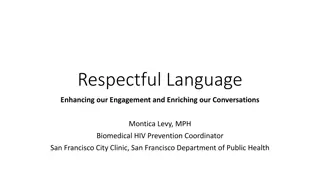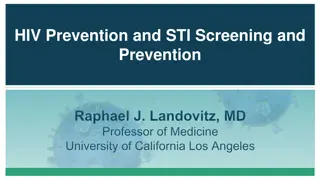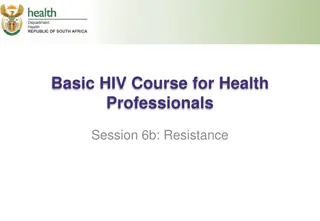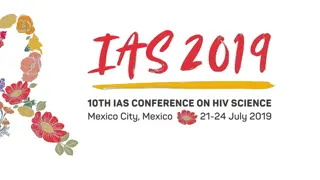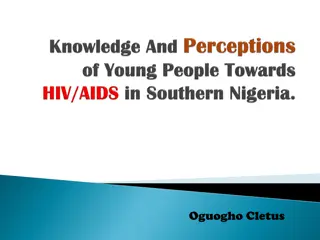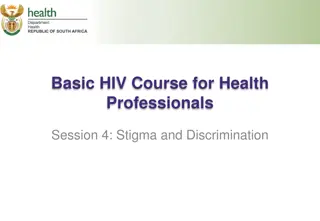Breaking Barriers: Understanding U=U in HIV Prevention
The concept of Undetectable=Untransmittable (U=U) has reshaped how we approach HIV prevention, with evidence emphasizing viral load as a key factor in transmission risk. Landmark studies like the Partner Study and HPTN 052 have solidified the U=U message, showcasing significant reductions in HIV transmission. The message has gained momentum since 2017, with growing support from research and expert opinions. The Rakai study in Uganda and the Partner Study further highlight the effectiveness of U=U in preventing transmission among HIV serodifferent couples. These findings underscore the importance of viral suppression and early antiretroviral therapy in reducing HIV transmission risk.
Download Presentation

Please find below an Image/Link to download the presentation.
The content on the website is provided AS IS for your information and personal use only. It may not be sold, licensed, or shared on other websites without obtaining consent from the author. Download presentation by click this link. If you encounter any issues during the download, it is possible that the publisher has removed the file from their server.
E N D
Presentation Transcript
Undetectable = Untransmittable (U = U)
U=U: Building the evidence The evidence, experience and expert opinion to support the U=U message has been increasing over two decades1 Viral load is the single biggest determinant of HIV transmission risk1,2 The Partner study was the tipping point in our understanding and our approach to messaging2 The results of Partner 2 gave us the confidence to be definitive about the messaging and language around U=U3 1. 2. 3. U=U taking off in 2017. Editorial Lancet HIV 2017;4(11):e475; Rodger AJ et al. JAMA 2016;316(2):171 81 Rodger AJ et al. HIV transmission risk through condomless sex in gay couples with suppressive ART: The PARTNER2 Study extended results in gay men. IAS 2018
U=U: Building the evidence Rakai study of 415 HIV serodifferent heterosexual couples in Uganda 35 All subjects Male-to-female transmission Female-to-Male transmission Transmission rate per 100 person-years 30 25 20 15 10 5 0 HIV-1 RNA (copies/ml) No cases of transmission to sexual partners observed for patients with VL <1,500 copies/mL RNA, ribonucleic acid; VL, viral load. Quinn TC et al. N Engl J Med 2000;342:921 9.
U=U: Building the evidence HPTN 052: Study design Stable, healthy, HIV serodifferent, sexually active couples CD4 count: 350 550 cells/mm3 Randomisation Immediate ART CD4 350 550 cells/mm3 Delayed ART Initiated when CD4 250 cells/mm3 Primary transmission endpoint Virologically-linked transmission events Primary clinical endpoint WHO stage 4 clinical events, pulmonary tuberculosis, severe bacterial infection and/or death ART, antiretroviral therapy; CD4, cluster of differentiation 4; HPTN, HIV Prevention Trials Network; WHO, World Health Organization. Cohen MS et al. NEJM 2011;365:493 505.
U=U: Building the evidence Total HIV-1 transmission events: 78 Linked transmissions: 46 Unlinked transmissions: 26 93% reduction in HIV transmission Hazard Ratio 0.07% (0.02 0.22) P<0.05 Delayed ART: 43 Immediate ART: 3 Antretroviral Therapy for the Prevention of HIV-1 Transmission Cohen MS et al. N Engl J Med 2016; 375:830-839
U=U: Building the evidence Partner Study Design: 888 HIV serodifferent couples (548 heterosexual and 340 MSM) HIV-positive partner on ART with a viral load <200 copies/mL 75 European clinical sites Primary aim: To study the risk of HIV transmission through anal and vaginal sex in the absence of condom use for people with an undetectable viral load ART, antiretroviral therapy; MSM, men who have sex with men Rodger AJ et al. JAMA 2016;316(2):171 81.
U=U: Building the evidence Partner Study: Results 1,238 eligible CYFU 58,000 condomless sex acts 11 of the initially HIV-negative partners became HIV-1 infected ZERO transmissions linked to their HIV positive partner 8 (73%) reported recent condomless sex with others apart from their study partner Overall transmission risk was zero (95% CI 0 0.3/100 CYFU) 18% 6% of MSM and of heterosexuals reported STIs CI, confidence interval; CYFU, couple years of follow-up; MSM, men who have sex with men; STI, sexually transmitted infection. Rodger AJ et al. JAMA 2016;316(2):171 81.
U=U: Building the evidence Partner Study: Rate of HIV transmission according to sexual behaviour reported by the HIV- partner (All couples) % of eligible couples reporting specific sex act Couple-years of follow-up Any sex Vaginal sex Anal sex Insertive anal sex Receptive anal sex with ejaculation 99.7 60.6 52.9 42.1 21.4 1,238 629 522 417 166 0 1 2 3 4 Rate of within-couple transmission, per 100 couple-years of follow-up Rodger AJ et al. JAMA 2016;316(2):171 81.
U=U: Building the evidence Partner Study: Rate of HIV transmission according to sexual behaviour reported by the HIV- partner (All couples) % of eligible couples reporting specific sex act Upper 95% confidence limit Couple-years of follow-up Any sex Vaginal sex Anal sex Insertive anal sex Receptive anal sex with ejaculation 99.7 60.6 52.9 42.1 21.4 1,238 629 522 417 166 0.30 0.59 0.71 0.88 2.23 0 1 2 3 4 Rate of within-couple transmission, per 100 couple-years of follow-up Rodger AJ et al. JAMA 2016;316(2):171 81.
U=U: Building the evidence Partner 2 Study Design: 972 HIV serodifferent MSM couples 783 couples contributed to the analysis HIV-positive partner on ART with a viral load <200 copies/mL Primary aim: To follow serodifferent partnerships that have penetrative sex without using condoms where the HIV-positive partner is on ART with a plasma HIV-1 RNA load <200 copies/mL to study risk of HIV transmission through anal sex in the absence of condom use ART, antiretroviral therapy; MSM, men who have sex with men. Rodger AJ et al. Risk of HIV transmission through condomless sex in serodifferent gay couples with the HIV-positive partner taking suppressive antiretroviral therapy (PARTNER): final results of a multicentre, prospective, observational study. Lancet 2019 Jun 15;393(10189):2428-2438
U=U: Building the evidence Partner 2 Study: Results 1,596 eligible CYFU 77,000 condomless sex acts 15 of the initially HIV-negative partners became HIV-1 infected ZERO transmissions linked to their HIV positive partner 11 (73%) reported recent condomless sex with others apart from their study partner Overall transmission for MSM in Partner 1 and 2 was zero (95% CI 0 0.23/100 CYFU) of HIV +ve partners reported STIs of HIV -ve partners and 18% 27% CI, confidence interval; CYFU, couple years of follow-up; MSM, men who have sex with men; STI, sexually transmitted infection. Rodger AJ et al. Risk of HIV transmission through condomless sex in serodifferent gay couples with the HIV-positive partner taking suppressive antiretroviral therapy (PARTNER): final results of a multicentre, prospective, observational study. Lancet 2019 Jun 15;393(10189):2428-2438
Why this is important Removes the shame and fear of sexual transmission Simplifies the possibility for conception Changes the approach to HIV criminalisation Tackles HIV stigma Encourages people to test, engage in care and to start and stay on treatment1,2 Author s opinion. 1. Okoli et al Undetectable equals untransmittable (U = U): awareness and associations with health outcomes among people living with HIV in 25 countries. Sexually Transmitted Infections 2021;97:18-26. 2. Smith P et al Undetectable = Untransmittable (U = U) Messaging Increases Uptake of HIV Testing Among Men: Results from a Pilot Cluster Randomized Trial AIDS and Behavior . https://doi.org/10.1007/s10461-021-03284-y
2019 Positive Perspectives Survey Improving communication and engagement with patients Exploration of associations with indicators of quality of life and Patient Reported Outcomes (PROs) among People living with HIV (N=2389) Relationship Between Engagement in Care and PROs Adjusted Odds Ratio (95% CI) for exposed vs not to HCP behavior Proportion Informed of U=U by HCPs, by Country Switzerland 87% Austria 84% Patient-reported Outcome Adjusted Odds Ratio* Specific HCP Behavior Australia 80% Portugal 78% Ireland 78% Patients feels knowledgeable about HIV Belgium 76% 5.9 (4.9-.7.2) i Provides enough information Netherlands 75% Germany 71% France 71% USA 71% 4.6 (3.8-5.6) Asks about ART side effects Chile 70% South Africa 70% 4.5 (3.7-5.5) Seeks patients view on treatment UK 69% Patients report that their treatment needs are met Italy 68% 4.3 (3.6-5.2) Spain 67% Discusses new treatment options Argentina 66% Taiwan 64% ? 3.7 (3.1-4.5) Inquires about treatment concerns Mexico 60% Japan 59% U=U 2.9 (2.4-3.5) Informed patient of U=U Poland 56% Canada 56% Brazil 48% * Logistic regression models controlled for gender, sexual orientation, age, duration of disease, comorbidities, region, and education. Values indicated with confidence intervals (CL) Russia 46% China 40% South Korea 38% 0% 20% 40% 60% 80% 100% Improving quality of communication between People living with HIV and Healthcare Professionals may better support improved quality of life *Odds of PRO based on exposure vs no exposure to HCP behavior HCPs, healthcare providers Okoli et al Undetectable equals untransmittable (U = U): awareness and associations with health outcomes among people living with HIV in 25 countries. Sexually Transmitted Infections 2021;97:18-26
2019 Positive Perspectives Survey U=U Information-Sharing by Healthcare Providers Cross-country analysis to investigate association of proportion of people living with HIV informed of U=U by HCPs with PROs (April 2019-January 2020; N=2389) Told of U=U by HCP (N=1588) Not told of U=U by HCP (N=801) 100% 90% 80% 80% People living with HIV, % 77% 76% 80% 69% 68% 70% 63% 62% 61% 57% 60% 51% 51% 48% 50% 43% 40% 30% 20% 10% 0% Optimal adherence Belief that ART prevents transmission Viral suppression Treatment satisfaction Optimal mental health Optimal overall health Optimal sexual health People living with HIV who reported being informed of U=U by HCPs were more likely to report favourable PROs (all P<0.001) PRO, patient-reported outcomes Okoli et al Undetectable equals untransmittable (U = U): awareness and associations with health outcomes among people living with HIV in 25 countries. Sexually Transmitted Infections 2021;97:18-26
Individual and public health impact of U = U Peer delivered U = U messaging increased uptake of HIV testing in South Africa1 RCT comparing standard of care of peer promoters informing men of the availability of HIV testing at mobile clinics with intervention days when peer promoters delivered the U = U message Peer promoters delivered 1048 invitations over 12 days. In the Standard of Care group, 68 (13%) of 544 men invited tested for HIV 3 (4.4%) HIV-positive In the U = U group, 112 (22%) of 504 men invited tested for HIV 7 (6.3%) HIV-positive Men in the U = U group had greater odds of testing for HIV Adjusted odds ratio = 1.89, 95% CI 1.21 2.95; p = 0.01 Information about U=U (from peer promoters) increased uptake of HIV testing which has both individual and public health benefits . 1. AIDS and Behavior . https://doi.org/10.1007/s10461-021-03284-y Smith P et al Undetectable = Untransmittable (U = U) Messaging Increases Uptake of HIV Testing Among Men: Results from a Pilot Cluster Randomized Trial
Communicating the message www.tht.org.uk accessed July 2021
Multiple UK and international resources Avert via https://www.avert.org/ i-base via https://i-base.info/u-equals-u/ London HIV Prevention Programme - Do It London Via https://doitlondon.org/undetectable/ NAM via https://www.aidsmap.com/ National AIDS Trust (NAT) via https://www.nat.org.uk/ Saving Lives via https://www.savinglivesuk.com/ Prevention Access Campaign global resources https://www.preventionaccess.org/resources List not intended to be exhaustive
Communicating the message Knowledge about HIV (and U=U) remains poor in those not working in HIV In a survey of 411 staff working at St Bartholomew's Hospital, the Royal London Hospital and Newham Hospital: The respondents were predominantly nurses (57%), healthcare assistants (19%) and doctors (12%) working in adult medical, surgical and critical care wards, accident & emergency and theatres. Three-quarters would not be confident discussing HIV status with a patient. A quarter would isolate HIV-positive patients in side-rooms and half thought they should be operated on at the end of the day, due to a risk of contamination. 80% had not heard of U=U. 35% did not think that a person living with HIV can conceive and have children who are HIV negative. 82% said they would like more information and training on HIV Shongwe M et al. Measuring healthcare HIV knowledge within our NHS Trust. British HIV Association conference, abstract O06, November 2020
Putting this into practice Communicating U = U with patients
Defining U=U There is no risk of transmission when someone has been on treatment for 6 months and has an undetectable viral load1 Rather than .. There is no risk of transmission when someone is on treatment and has had an undetectable viral load for 6 months An undetectable viral load is defined as anything < 200 rna copies/ml2 1. 2. Mujugira et al. HIV Transmission Risk Persists During the First 6 Months of Antiretroviral Therapy JAIDS, 2016. 15;72(5):579-84 Rodger AJ et al. JAMA 2016;316(2):171 81.
Viral load blips and low level viraemia There is no risk of transmission as long as the viral load remains below 200 rna copies/ml1 Viral load blips , where the viral load remains below 200 rna copies/ml, are not a concern for transmission1 Good adherence is key. As long as that is maintained, people living with HIV can be confident they are maintaining an undetectable viral load. Detectable viral loads in people established on therapy are not common2 U=U does not apply if the viral load is > 200 rna copies/ml1 1. 2. Rodger AJ et al. JAMA 2016;316(2):171 81 Conner et al. Durability of viral suppression with first-line antiretroviral therapy in patients with HIV in the UK: an observational cohort study. Lancet HIV. 2017;4(7):e295-e302.
Breast Feeding (and other settings) U = U only applies to sexual transmission An undetectable viral load makes transmission in other settings rare but possible Suppressive maternal antiretroviral therapy significantly reduces, but does not eliminate, the risk of vertical transmission and we currently lack data to apply the U=U statement to breastfeeding.1,2,3 In the UK we recommend that women living with HIV do not breastfeed as there are alternatives1. However woman can choose to breastfeed if they want to (and should be supported to do so). BHIVA has guidance and patient info on how to do this safely4 1. 2. 3. BHIVA guidelines. https://www.bhiva.org/file/5f1aab1ab9aba/BHIVA-Pregnancy-guidelines-2020-3rd-interim-update.pdf Shapiro et al Antiretroviral Regimens in Pregnancy and Breast-Feeding in Botswana. N Engl J Med. 2010 Jun 17; 362(24): 2282 2294. Giuliano et al Maternal Antiretroviral Therapy for the Prevention of Mother-To-Child Transmission of HIV in Malawi: Maternal and Infant Outcomes Two Years after Delivery. PLoS One. 2013; 8(7): e68950. https://journals.plos.org/plosone/article?id=10.1371/journal.pone.0068950 BHIVA guidelines for the management of HIV in pregnancy and postpartum 2018. https://www.bhiva.org/pregnancy-guidelines 4.
What about STIs? STIs do not increase the risk of transmission in the context of a viral load below 200 rna copies/ml In Partner 2: 18% of HIV negative and 27% of HIV positive partners reported STIs and there was still a zero risk of HIV transmission in the context of an undetectable viral load1. 1. Rodger AJ et al. Risk of HIV transmission through condomless sex in serodifferent gay couples with the HIV-positive partner taking suppressive antiretroviral therapy (PARTNER): final results of a multicentre, prospective, observational study. Lancet 2019 Jun 15;393(10189):2428-2438
The language we use If you believe it, so will they . Understanding the message has significant impact for individuals living with HIV Extremely unlikely Nearly impossible Close to zero Helps prevent HIV Healthcare professionals need to adopt a consistency of message around U=U The language we use makes a difference: Low risk ? Could Might - Can t pass it on Cannot transmit Zero risk Prevents HIV - ? Can t Won t No risk
British HIV Association (BHIVA) are clear on U = U BHIVA statement on U=U We urge health care professionals to discuss U=U proactively with all people living with HIV at appropriate points during care including, but not limited to:- at diagnosis, when initiating treatment, to encourage adherence, when undetectable, and if planning to conceive. We recommend consistent and unambiguous terminology when discussing U=U such as "no risk" or "zero risk" of sexual transmission of HIV, avoiding terms like "negligible risk" and "minimal risk." BHIVA encourages universal promotion of Undetectable=Untransmittable (U=U), via https://www.bhiva.org/BHIVA-encourages-universal-promotion-of-U-U
Zero risk, Zero excuses #CantPassItOn #UequalsU www.tht.org.uk accessed July 2021 www.preventionaccess.org accessed July 2021
